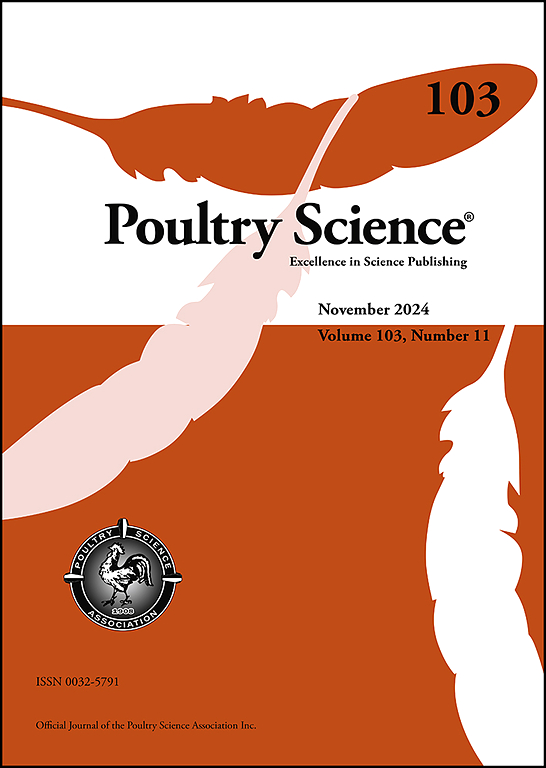Effects of inclusion level of black soldier fly larvae protein or oil on broiler growth performance during heat stress
IF 4.2
1区 农林科学
Q1 AGRICULTURE, DAIRY & ANIMAL SCIENCE
引用次数: 0
Abstract
Beyond their nutritional value, insects contain bioactive compounds, including chitin, lauric acid, and antimicrobial peptides, and could potentially exert positive effects on animals consuming insect-based diets in health challenging conditions. A total of 648 Ross 308 male chicks were fed four different soybean meal-maize-wheat based diets in which soybean meal or oil was partly replaced by black soldier fly larvae (BSFL) protein or oil, respectively, in cyclic heat stress or thermoneutral (control) conditions. BSFL protein or oil was included at 5 and 10 %, and 2 and 4 %, respectively, in a 2 × 2 × 3 factorial design. The growth performance (ADFI, ADG, body weight gain : feed intake ratio (G:F), and mortality) was recorded at d 9, 21, and 34. Carcass yields were determined at 35 d of age and blood and ileal tissue samples were collected to examine heat stress-related biomarkers.
The heat stress challenge was successfully implemented, demonstrated by a significant reduction in ADFI, with numerical reductions in ADG and final BW across the overall trial. The cyclic heat stress applied was mild and chronic, with mortality and removals recorded at 2 %. Broilers exposed to heat stress showed elevated levels of ileum calprotectin, while serum corticosterone levels tended to be lower compared to controls.
A significant interaction was observed between heat stress, insect product, and inclusion level. In heat stress conditions, the inclusion of BSFL oil led to a numerical increase in ADFI, ADG, and BW, whereas inclusion of BSFL protein resulted in a numerical decrease in BW. BSFL protein at 5 and 10 % and BSFL oil at 2 and 4 % inclusion level did not exhibit notable growth performance benefits in Ross 308 broilers under mild cyclic heat stress conditions. The mild nature of the heat stress challenge may have limited the detection of BSFL product effects, highlighting the need for future investigations under more intense heat stress conditions.
热应激条件下黑兵蝇幼虫蛋白质或油包合水平对肉鸡生长性能的影响。
除了营养价值外,昆虫还含有生物活性化合物,包括几丁质、月桂酸和抗菌肽,可能对在健康状况不佳的情况下食用昆虫类食物的动物产生积极影响。在循环热应激和热中性(对照)条件下,648只罗斯308雄性雏鸡分别饲喂4种不同的豆粕-玉米-小麦为基础的饲粮,其中黑兵蝇幼虫(BSFL)蛋白质或油部分替代豆粕或豆油。在2 × 2 × 3因子设计中,BSFL蛋白或油分别加入5%和10%,2%和4%。分别于第9、21和34天记录生长性能(ADFI、ADG、增重采食量比(G:F)和死亡率)。在35日龄时测定胴体产量,并收集血液和回肠组织样本以检测与热应激相关的生物标志物。在整个试验过程中,热应力挑战成功实施,ADFI显著降低,ADG和最终体重均有所降低。应用的循环热应力是轻度和慢性的,死亡率和去除率记录为2%。暴露于热应激的肉鸡回肠钙保护蛋白水平升高,而血清皮质酮水平往往低于对照组。热应激、虫产物和包涵体水平之间存在显著的交互作用。在热应激条件下,BSFL油包埋导致ADFI、ADG和BW数值升高,而BSFL蛋白包埋导致BW数值降低。轻度循环热应激条件下,5%和10%的BSFL蛋白和2%和4%的BSFL油对罗斯308肉鸡的生长性能没有显著的促进作用。热应激挑战的温和性质可能限制了BSFL产品效应的检测,强调了在更强烈的热应激条件下进行未来研究的必要性。
本文章由计算机程序翻译,如有差异,请以英文原文为准。
求助全文
约1分钟内获得全文
求助全文
来源期刊

Poultry Science
农林科学-奶制品与动物科学
CiteScore
7.60
自引率
15.90%
发文量
0
审稿时长
94 days
期刊介绍:
First self-published in 1921, Poultry Science is an internationally renowned monthly journal, known as the authoritative source for a broad range of poultry information and high-caliber research. The journal plays a pivotal role in the dissemination of preeminent poultry-related knowledge across all disciplines. As of January 2020, Poultry Science will become an Open Access journal with no subscription charges, meaning authors who publish here can make their research immediately, permanently, and freely accessible worldwide while retaining copyright to their work. Papers submitted for publication after October 1, 2019 will be published as Open Access papers.
An international journal, Poultry Science publishes original papers, research notes, symposium papers, and reviews of basic science as applied to poultry. This authoritative source of poultry information is consistently ranked by ISI Impact Factor as one of the top 10 agriculture, dairy and animal science journals to deliver high-caliber research. Currently it is the highest-ranked (by Impact Factor and Eigenfactor) journal dedicated to publishing poultry research. Subject areas include breeding, genetics, education, production, management, environment, health, behavior, welfare, immunology, molecular biology, metabolism, nutrition, physiology, reproduction, processing, and products.
 求助内容:
求助内容: 应助结果提醒方式:
应助结果提醒方式:


